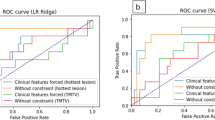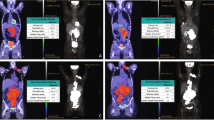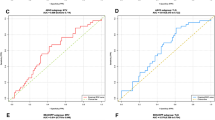Abstract
We investigated the predictive value of sequential FDG PET before and after high-dose chemotherapy (HDT) and autologous stem cell transplantation (ASCT) in 24 patients suffering from non-Hodgkin's lymphoma (NHL). FDG PET was performed at baseline, after three cycles of induction therapy, before and after HDT with ASCT. Response assessment from sequential PET scans using standardized uptake values (SUV) was available in 22 patients at the time of transplantation. Partial metabolic response (PMR) was defined as a <25% decrease of SUV between successive PET scans. Six of seven patients who did not achieve a PMR after complete induction therapy developed lymphoma progression, while 10 of 15 patients with complete metabolic response (CMR) or PMR remained in continuous remission. Four of seven patients with less than PMR after induction therapy died vstwo of 15 patients with CMR/PMR. Median progression-free and overall survival of patients with less than PMR after HDT and ASCT was 9 and 29 months, respectively. In contrast, neither conventional re-staging nor the International Prognostic Index were predictive. These data suggest that sequential quantitative PET imaging does enlarge the concept of chemosensitivity used to select patients with high-risk NHL for HDT and ASCT or to route them to alternative treatments.
This is a preview of subscription content, access via your institution
Access options
Subscribe to this journal
Receive 12 print issues and online access
$259.00 per year
only $21.58 per issue
Buy this article
- Purchase on Springer Link
- Instant access to full article PDF
Prices may be subject to local taxes which are calculated during checkout




Similar content being viewed by others
References
Philip T, Guglielmi C, Hagenbeek A et al. Autologous bone marrow transplantation as compared with salvage chemotherapy in relapses of chemotherapy-sensitive non-Hodgkin's lymphoma New Engl J Med 1995 333: 1540 1545
The International Non-Hodgkin's Lymphoma Prognostic Factors Project. A predictive model for aggressive non-Hodgkin's lymphoma New Engl J Med 1993 329: 987 994
Moog F, Bangerter M, Diederichs CG et al. Lymphoma: role of whole-body 2-deoxy-2-[F18]fluoro-D-glucose (FDG) PET in nodal staging Radiology 1997 203: 795 800
Moog F, Bangerter M, Diederichs CG et al. Extranodal malignant lymphoma: detection of FDG PET versus CT Radiology 1998 206: 475 481
Cremerius U, Fabry U, Kröll U et al. Clinical value of FDG PET for therapy monitoring of malignant lymphomas – results of a retrospective study in 72 patients Nuklearmedizin 1999 38: 24 30
Jerusalem G, Beguin Y, Fasotte MF et al. Whole-body positron emission tomography using 18F-fluorodeoxyglucose for posttreatment evaluation in Hodgkin's disease and non-Hodgkin's lymphoma has higher diagnostic and prognostic value than classical computed tomography scan imaging Blood 1999 94: 429 433
Spaepen K, Stroobants S, Dupont P et al. Prognostic value of positron emission tomography (PET) with fluorine-18 fluorodeoxyglucose ([18F]FDG) after first-line chemotherapy in non-Hodgkin's lymphoma: is [18F]FDG-PET a valid alternative to conventional diagnostic methods? J Clin Oncol 2001 19: 414 419
Jerusalem G, Beguin Y, Fassotte MF et al. Persistent tumor 18F-FDG uptake after a few cycles of polychemotherapy is predictive of treatment failure in non-Hodgkin's lymphoma Haematologica 2000 85: 613 618
Cremerius U, Fabry U, Neuerburg J et al. Prognostic significance of positron emission tomography using fluorine-18-fluorodeoxyglucose in patients treated for malignant lymphoma Nuklearmedizin 2001 40: 23 30
Young H, Baum R, Cremerius U et al. Measurement of clinical and subclinical tumour response using [18F]-fluorodeoxyglucose and positron emission tomography: review and 1999 EORTC recommendations Eur J Cancer 1999 35: 1773 1782
Roemer W, Hanauske AR, Ziegler S et al. Positron emission tomography in non-Hodgkin's lymphoma: assessment of chemotherapy with fluorodeoxyglucose Blood 1998 91: 4464 4471
Jaffe ES, Harris NL, Diebold J et al. World Health Organisation classification of lymphomas: a work in progress Ann Oncol 1998 9: (Suppl. 5) S25 S30
Strauss LG, Conti PS . The applications of PET in clinical oncology J Nucl Med 1991 32: 623 648
Thill R, Neuerburg J, Fabry U et al. Comparison of findings with 18-FDG-PET and CT in pretherapeutic staging of malignant lymphoma Nuklearmedizin 1997 36: 234 239
Cheson BD, Horning SJ, Coiffier B et al. Report of an international workshop to standardize response criteria for non-Hodgkin's lymphomas J Clin Oncol 1999 17: 1244 1253
Vose JM, Anderson JR, Kessinger A et al. High-dose chemotherapy and autologous hematopoietic stem-cell transplantation for aggressive non-Hodgkin's lymphoma J Clin Oncol 1993 11: 1846 1851
Kaplan EL, Meier P . Nonparametric estimation from incomplete observations J Am Stat Assoc 1958 53: 457 481
Becherer A, Mitterbauer M, Jaeger U et al. Positron emission tomography with [18F]2-fluoro-D-2-deoxyglucose (FDG-PET) predicts relapse of malignant lymphoma after high-dose therapy with stem cell transplantation Leukemia 2002 16: 260 267
Rodriguez M, Rehn S, Ahlström H et al. Predicting malignancy grade with PET in non-Hodgkin's lymphoma J Nucl Med 1995 36: 1790 1796
Sugawara Y, Fisher SJ, Zasadny KR et al. Preclinical and clinical studies of bone marrow uptake of fluorine-18-fluorodeoxyglucose with or without granulocyte colony stimulating factor during chemotherapy J Clin Oncol 1998 16: 173 180
Kessler RM, Ellis JR, Eden M . Analysis of emission tomographic data: limitations imposed by resolution and background J Comput Assist Tomogr 1984 8: 514 522
Acknowledgements
The authors thank the staff of the Nuclear Medicine Department for assistance in PET acquisition and image documentation and interpretation and Peter Glatte and Stefan Reismann for collecting and handling the clinical and PET data. Moreover we thank Prof Johann Lorenzen for a thorough review of the histopathological lymphoma classification and Prof Ralf-Dieter Hilgers for his valuable advice concerning the statistics. The study has been supported by a grant from the Medical Faculty of the Aachen University of Technology.
Author information
Authors and Affiliations
Rights and permissions
About this article
Cite this article
Cremerius, U., Fabry, U., Wildberger, J. et al. Pre-transplant positron emission tomography (PET) using fluorine-18-fluoro-deoxyglucose (FDG) predicts outcome in patients treated with high-dose chemotherapy and autologous stem cell transplantation for non-Hodgkin's lymphoma. Bone Marrow Transplant 30, 103–111 (2002). https://doi.org/10.1038/sj.bmt.1703607
Received:
Accepted:
Published:
Issue Date:
DOI: https://doi.org/10.1038/sj.bmt.1703607
Keywords
This article is cited by
-
FDG-PET for the early treatment monitoring, for final response and follow-up evaluation in lymphoma
Clinical and Translational Imaging (2015)
-
Current role of FDG PET/CT in lymphoma
European Journal of Nuclear Medicine and Molecular Imaging (2014)
-
The role of 18F-fluorodeoxyglucose positron emission tomography at response assessment after autologous stem cell transplantation in T-cell non-Hodgkin’s lymphoma patients
Annals of Hematology (2013)
-
Early post transplant (F-18) 2-fluoro-2-deoxyglucose positron emission tomography does not predict outcome for patients undergoing auto-SCT in non-Hodgkin and Hodgkin lymphoma
Bone Marrow Transplantation (2011)
-
Unifying the predictive value of pretransplant FDG PET in patients with lymphoma: a review and meta-analysis of published trials
European Journal of Nuclear Medicine and Molecular Imaging (2010)



